Contents
- UN draft declaration and India’s demand for reform
- China has crossed its 1960 claims along the LAC
- Private units voice concern over imports of small arms
- Growers wary of Rubber Act’s repeal
- Transmission of Coronavirus across the placenta
- Faults at the foot of the Himalaya discovered
- Hiring optimism grows as demand gathers pace
UN DRAFT DECLARATION AND INDIA’S DEMAND FOR REFORM
Focus: GS-II International Relations
Why in news?
- The final draft of the Declaration on the Commemoration of the Seventy-Fifth Anniversary of the U.N. favours a softer approach to the process of the expansion of membership.
- The Declaration is a powerful reiteration of the U.N.’s founding principles that brought a new world order 75 years ago in the backdrop of the World War II.
- The declaration did mention that U.N. commits to instill new life in the discussions on the reform of the Security Council, however, mention of ‘discussions’ is being interpreted as dilution of the progress made on the path of reform of the principal organs of the U.N.
Question of equitable representation
- In 2008, the General Assembly had ‘decided’ to proceed with the “modalities in order to prepare and facilitate intergovernmental negotiations on the question of equitable representation on and increase in the membership of the Security Council and other matters related to the Council”.
- In 2005, the call for reform was demanded in the backdrop of widespread unilateral decisions as seen during the Iraq war of 2003 and the “war on terror”, expressing strong global will to stop misuse of military power.
- Mention of just ‘discussion’ in the draft final statement in place of ‘negotiations’ shows the Security Council’s expansion and reform have received a textual setback.
India’s Stance
- India’s diplomatic machinery repeatedly urged for strengthening of the UNSC by including new members.
- As of now developing or emerging economies are not adequately represented in the highest organs with only one developing country, that is China, participating in the global high tables of the U.N. on an equal basis armed with the right of veto.
- India became a non-permanent member of the Security Council for a single year term of 2021-22, and this was seen as a boost for its demand for the actual reform and expansion of the UNSC.
- The demand for expansion was also present, in call for a “reformed multilateralism”, in the India Prime Minister’s keynote address at the High-Level Segment of the United Nations Economic and Social Council (ECOSOC).
- India’s 2021-’22 tenure will end as it will take over presidency of G20.
Click Here to read more about the PM’s Keynote Address at ECOSOC
Click Here to read more about UNSC and India’s Position
-Source: The Hindu
CHINA HAS CROSSED ITS 1960 CLAIMS ALONG THE LAC
Focus: GS-II International Relations
Why in news?
Chinese troops are currently present on the north bank of Pangong Lake in Ladakh in an area that is beyond what even China described as its official boundary during talks with India in 1960.
Details
The records contradict China’s current claims of where the Line of Actual Control (LAC) runs.
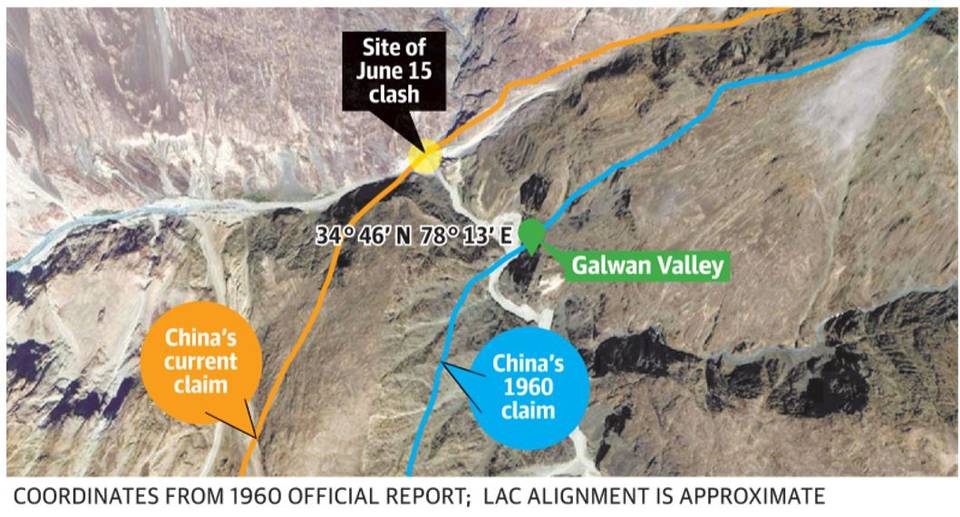
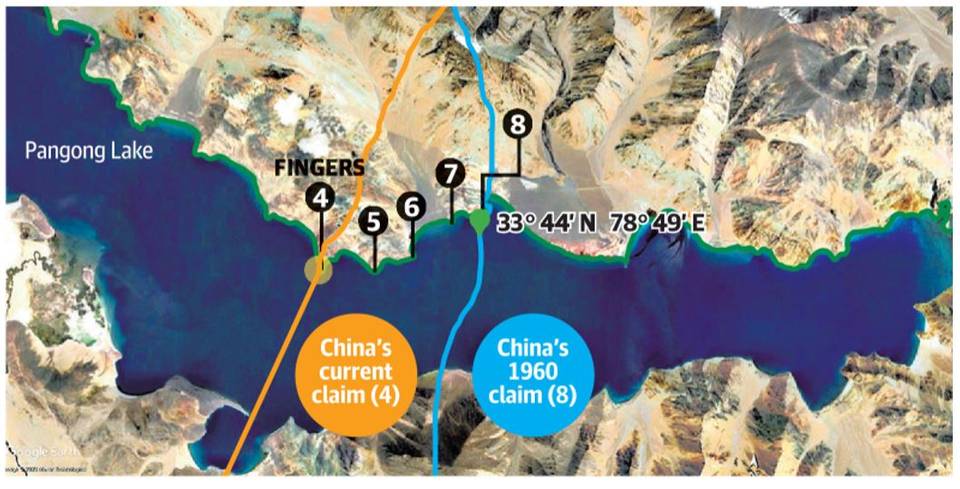
Shifting Positions
- In 1960, India certainly viewed China’s presence in areas where the People’s Liberation Army (PLA) transgressed in May 2020 as being beyond Beijing’s own territorial claims.
- At the north bank of Pangong Tso, the PLA moved up to Finger 4 and prevented India from crossing Finger 4.
- China now claims up to Finger 4, while India says the LAC is at Finger 8.
- However, since May 2020, for the first time, completely cut off India’s access to its LAC at Finger 8, effectively shifting the line 8 km west.
- China’s current moves to enforce its Line of Actual Control (LAC) claims, which sparked the recent border incidents, mark a shift from what Beijing told India in 1960 about where its boundaries were, both in the Galwan Valley and Pangong Lake.
The Fingers refer to mountain spurs on the bank, and run from 1 to 8, west to east.
MEA report
Regarding Pangong Lake
- Following border talks in 1960, that failed to break the impasse, it was decided that officials of the two governments would meet “to examine factual materials in the possession of the two governments to support their stands.”
- Three rounds of talks were held, and following the final session in Rangoon – the official report was signed.
- In this report, the coordinates of the point where the Chinese side said it reached the Pangong Lake – roughly corresponds to an area near Finger 8.
- However, now this point is around 8 km east of where China now says the LAC is (and where it transgressed in May 2020).
Regarding the Galwan Valley
Regarding the Galwan Valley, based on Chinese response to when India asked for heights of peaks and locations of passes (to demarcate) in the area in 1960, China has gone beyond its 1960 claims both in Pangong Tso and in the Galwan Valley.
In the Galwan Valley, the 1960 line ran east of the bend of the Galwan river, called the Y-nallah. This is the site of the clash in June 2020.
Click Here to read more about Aksai Chin and History of India – Chine Border Dispute
-Source: The Hindu
PRIVATE UNITS VOICE CONCERN OVER IMPORTS OF SMALL ARMS
Focus: GS-III Indian Economy, Internal Security Challenges
Why in news?
With Army taking a decision to order another 72,400 assault rifles from Sig Sauer of the U.S., domestic small arms manufacturers have expressed concern over continuing imports.
Details
- The official said Indian companies are not considered for deals through Fast Track Procurement (FTP), which is limited to foreign vendors currently.
- Under a ₹700 crore deal with Sig Sauer of the U.S., the Defence Ministry procured SIG-716 assault rifles through FTP.
- The remaining demand of over 7 lakh rifles was to be met through the licensed manufacture of Russian AK-203 rifles in India through a joint venture with the (OFB) Ordnance Factory Board (the final deal has been stuck over the issue of pricing).
- The Army has been attempting to replace the indigenous INSAS (Indian National Small Arms System) rifles with a modern rifle.
- In the last few years, several Indian companies have invested in the small arms segment, given the large requirement and efforts by government to open up ammunition to the private sector and have started production as well.
- However, without any major order from the armed forces, many companies are looking for smaller orders from police and Central Armed Police Forces (CAPF).
Military budget of India
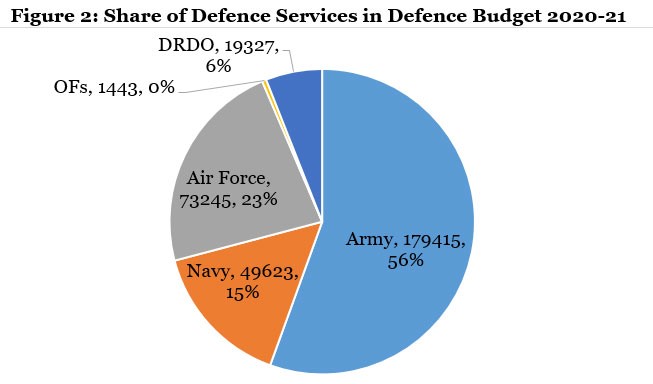
- In the 2020 budget – the allocation for defence during the fiscal year 2020-21 stood at more than Rs. 470 thousand crores, this amounted to an increase of just below 7%.
- The Indian Army accounts for more than half of the total defence budget of India, with most of the expenditure going to the maintenance of cantonments, salaries and pensions, instead of critical arms and ammunition.
- It may be seen from data of economic survey that Defence Budget as a percentage of GDP may appear to be decreasing due to increasing trend in the growth of GDP. However, it is increasing in absolute terms, implying higher spending.
India’s Defence Imports
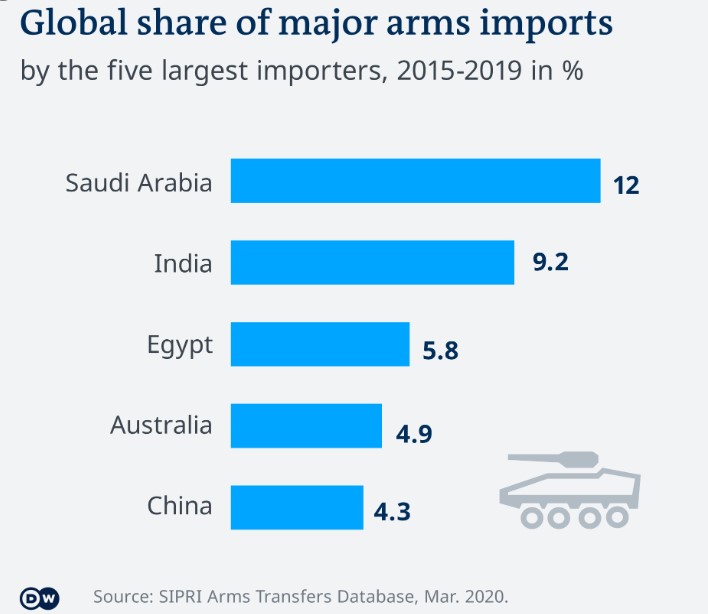
- India was the world’s second-largest arms importer from 2014-18, ceding the long-held tag as largest importer to Saudi Arabia, which accounted for 12% of the total imports during the period.
- However, Indian imports decreased by 24% between 2009-13 and 2014-18, partly due to delays in deliveries of arms produced under licence from foreign suppliers, such as combat aircraft ordered from Russia in 2001 and submarines ordered from France in 2008.
- Russia accounted for 58% of Indian arms imports in 2014–18, compared with 76% in 2009-13.
-Source: The Hindu
GROWERS WARY OF RUBBER ACT’S REPEAL
Focus: GS-III Agriculture
Why in news?
Concerns are being raised as the Centre plans to repeal the Rubber Act of 1947.
What are the concerns?
- The very existence of the Rubber Board, the system of licensing, extension, replanting, research, subsidies, control over export-import and a host of other support systems depend on the Act.
- Withdrawal of the Act would empower the Centre to disband the board and end the present system of rubber farming, growers’ representatives fear.
- The Union government had drawn up a list of obsolete Acts to be repealed. The Rubber and Tea Acts got into the list and since then there have been apprehensions about the future of these Acts.
Indian Rubber Indsutry
- India is currently the sixth largest producer of Natural Rubber (NR) in the world with one of the highest productivity.
- Traditional rubber-growing states comprising Kerala and Tamil Nadu account for 81% of production.
- Major non-traditional rubber growing regions are the North Eastern states of Tripura, Assam and Meghalaya, Odisha, Karnataka, Maharashtra and West Bengal.
- Around 40% of NR is imported from other major rubber producing countries such as Malaysia, Indonesia and China – due to deficit in production and spike in consumption.
- The rubber sector has about 1.3 million rubber farmers contributing to a ₹1-lakh crore industry.
- Rubber is a tropical tree and can grow in a wide range of soils, including clay, sand and loam, tolerating both acidic and alkaline soils, however, they need good drainage.
Rubber Act, 1947 and other Legislation regarding Rubber in India
- The Ministry of Commerce & Industry, Government of India, established the Rubber Board through the Rubber Act in 1947, hence the Rubber Board is a Statutory Body.
- The Rubber Board was established to strengthen the development of the rubber industry by offering financial assistance, consolatory and regulatory services.
- The board launched the National Rubber Policy in March 2019 to address the external and internal challenges faced by the Indian rubber industry.
- The Rubber Board, headquartered at Kottayam, Kerala, under the administration of the Ministry of Commerce and Industry.
Aims of National Rubber Policy:
- Constructing a well-developed value-chain of competitive rubber industry.
- Supplying materials of international standards to the national and global markets.
- Elevating the financial status of the entire stakeholder community
- To strengthen the manufacturing sector of the NR and encourage the export of rubber products.
-Source: The Hindu
TRANSMISSION OF CORONAVIRUS ACROSS THE PLACENTA
Focus: GS-III Science and Technology
Why in news?
A study has found evidence that confirms vertical transmission of SARS-CoV-2 virus from the mother to the foetus.
What is said regarding the transmission so far?
- Transmission through droplets and contact with contaminated surfaces seem to be the major routes of novel coronavirus spread.
- The World Health Organization recently acknowledged that “short-range aerosol transmission” of the virus (i.e., airborne spread) “cannot be ruled out” in specific indoor locations which are crowded, inadequately ventilated and where exposure to the infected person is over a prolonged period of time.
Details
- The Study found that the virus first occurs in the mother’s blood and later causes placental infection and inflammation.
- The virus then gets into the blood of the neonate following placental infection.
- The neonate also showed clinical manifestation of COVID-19 in terms of neurological signs and symptoms.
- To confirm infection in the newborn, the researchers collected blood and bronchoalveolar lavage samples soon after birth and tested them for the virus, both of which tested positive.
Click Here to read more about WHO on Airborne Spread of Coronavirus
-Source: The Hindu
FAULTS AT THE FOOT OF THE HIMALAYA DISCOVERED
Focus: GS-I Geography, Prelims
Why in news?
- Data from an oil and gas exploration company has now helped geologists discover a series of faults at the foot of the Himalaya.
- This fault system in the southeastern region of Nepal has the potential to cause earthquakes in the densely populated country.
How were the fault lines found?
- The team looked at seismic reflection data, which are routinely collected by exploration companies looking for oil and gas.
- In this method, seismic waves are produced by small explosions at multiple sources, and many recorders called geophones record the sound echoing off layers beneath the surface.
- The signals are combined to make an image that looks like a slice showing layers through the top few kilometres of the Earth’s crust.
Seismic waves: Can these new fault lines affect India?
- The faults were detected don’t appear to extend into India, but seismic waves from an earthquake occurring on them might affect regions of India near the border.
- Other similar faults might be present elsewhere along the southern edge of the Himalaya and might extend beneath northern India.
Click Here to read more about Earthquakes and Seismic Waves
Earthquake zones of India
- The major reason for the high frequency and intensity of the earthquakes is that the Indian plate is driving into Asia at a rate of approximately 47 mm/year.
- Geographical statistics of India show that more than 50% of the land is vulnerable to earthquakes.
- The latest version of seismic zoning map of India divides India into 4 seismic zones (Zone 2, 3, 4 and 5).
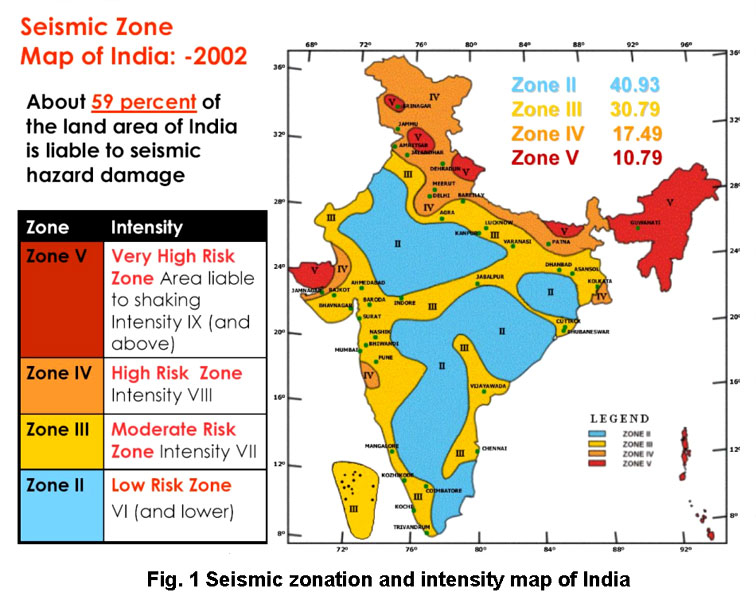
Zones of Seismicity
- Zone 1: Currently the Division does not include a Zone 1. NO area of India is classed as Zone 1.
- Zone 2: This region is liable to MSK VI or less and is classified as the Low Damage Risk Zone.
- Zone 3: This zone is classified as Moderate Damage Risk Zone which is liable to MSK VII.
- Zone 4: This zone is called the High Damage Risk Zone and covers areas liable to MSK VIII. Jammu and Kashmir, Ladakh, Himachal Pradesh, Uttarakhand, Sikkim, the parts of Indo-Gangetic plains (North Punjab, Chandigarh, Western Uttar Pradesh, Terai, North Bengal, Sundarbans) and the capital of the country Delhi fall in Zone 4.
- Zone 5: Zone 5 covers the areas with the highest risks zone that suffers earthquakes of intensity MSK IX or greater. The region of Kashmir, the Western and Central Himalayas, North and Middle Bihar, the North-East Indian region, the Rann of Kutch and the Andaman and Nicobar group of islands fall in this zone.
Measurement of earthquakes
The earthquake events are scaled either according to the magnitude or intensity of the shock.
- Richter scale – The magnitude scale is known as the Richter scale. The magnitude relates to the energy released during the quake. The magnitude is expressed in absolute numbers, 0-10.
- Mercalli scale – The intensity scale is named after Mercalli, an Italian seismologist. The intensity scale takes into account the visible damage caused by the event. The range of intensity scale is from 1-12.
- Medvedev–Sponheuer–Karnik scale – This is a macroseismic intensity scale used to evaluate the severity of ground shaking on the basis of observed effects in an area of the earthquake occurrence.
-Source: The Hindu
HIRING OPTIMISM GROWS AS DEMAND GATHERS PACE
Focus: GS-III Indian Economy
Why in news?
- India’s formal jobs market seems to be stabilizing and hiring is expected to pick up over the 6-month period after July 2020.
- However, the recovery seems to be uneven with most opportunities emerging from sectors that were least affected by the coronavirus lockdown.
Details
- Several industries such as education and healthcare are expected to lead the way in fresh recruitments as the spread of covid-19 and the lockdown have led to a sharp spike in demand.
- While the pandemic has forced many firms to downsize, a few industries are also benefiting from the changed realities of the post-pandemic world.
- Firms that express their intent to hire soon include those in healthcare, online education, e-commerce and consumer goods.
- Hiring by airlines, hotels and many manufacturing companies will likely remain weak.
- While hiring intent can change in future, the top-ranking sectors in the survey are expected to do the bulk of their hiring in the next six months.
- Firms in packaged consumer goods and farm equipment are likely to feel more confident about hiring as demand has either neared the pre-covid level or have exceeded it.
- Even as a demand revival takes hold, intermittent and localized lockdowns have disrupted manufacturing and supply chains.
- The e-commerce sector is expected to add a significant number of jobs.
- A good monsoon and the government’s increased allocation to rural employment schemes is expected to create a diverse range of jobs in the rural sector.
-Source: Livemint




